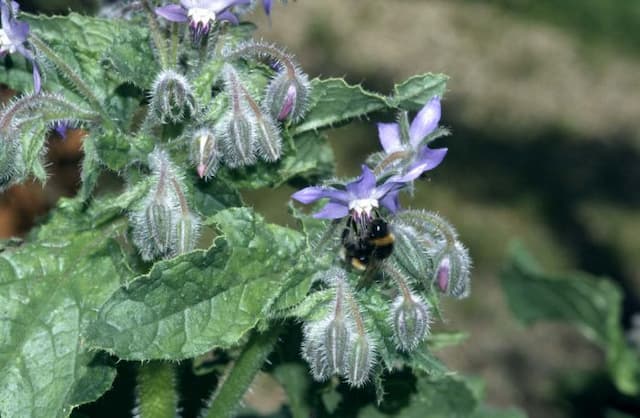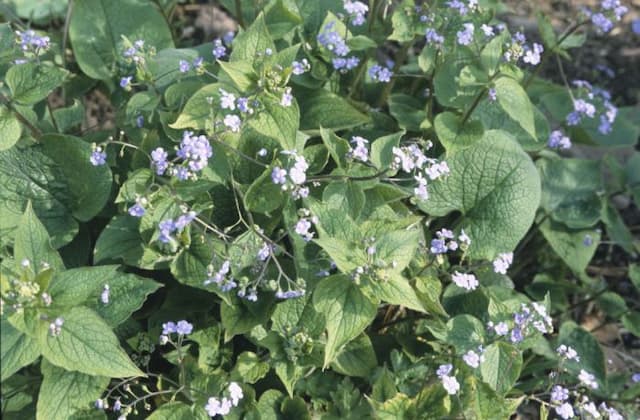Woodland Forget-Me-Not Myosotis sylvatica 'Bluesylva' (Sylva Series)

ABOUT
Myosotis sylvatica 'Bluesylva' is commonly known as forget-me-not. This plant is known for its charming and dainty appearance, with a profusion of tiny, delicate flowers. The blossoms are typically a deep, clear blue color, which is where the variety 'Bluesylva' gets its name. Each flower has a small yellow center that contrasts with the blue petals, creating an eye-catching effect. The petals are round and flat, forming a star-like shape around the central yellow eye. The leaves of the forget-me-not are soft and green. They have a slightly fuzzy texture with a lance-shaped to oblong form. Arranged alternately along the stems, the foliage complements the flowers and provides a lush backdrop that enhances the overall aesthetic of this plant. The stems are slender and may have a slight curve or bend due to the weight of the flowers and leaves. They contribute to the delicate and whimsical feel of 'Bluesylva', giving the plant an airy and graceful appearance. During its blooming period, this variety of forget-me-not creates a carpet of blue that can add a significant splash of color to gardens, borders, or any place they are grown. The effect is even more pronounced when these plants grow in large clusters, creating a sea of blue that is particularly striking during the spring and early summer months when they typically bloom.
About this plant
 Names
NamesFamily
Boraginaceae.
Synonyms
Wood Forget-Me-Not, Garden Forget-Me-Not, Forget-Me-Not.
Common names
Myosotis sylvatica 'Bluesylva' (Sylva Series).
 Toxicity
ToxicityTo humans
The Myosotis sylvatica 'Bluesylva' (Sylva Series) commonly known as the wood forget-me-not, is not generally considered toxic to humans. There is no widespread evidence to suggest that the ingestion or handling of wood forget-me-not poses significant risks of poisoning to people. Therefore, it is not typically associated with symptoms of poisoning and no specific consequences of ingestion are noted under normal circumstances.
To pets
The Myosotis sylvatica 'Bluesylva' (Sylva Series), commonly referred to as the wood forget-me-not, is not known to be toxic to pets. There is no common documentation on poisoning in pets such as dogs and cats from ingestion of this plant. As such, it is not generally associated with specific symptoms of poisoning or adverse effects upon ingestion. Nevertheless, it is always prudent to monitor pets and prevent them from eating plants as individual animals may have unique sensitivities or allergic reactions.
 Characteristics
CharacteristicsLife cycle
Biennials
Foliage type
Deciduous
Color of leaves
Green
Flower color
Blue
Height
0.5 feet (15 cm)
Spread
1 foot (30 cm)
Plant type
Herb
Hardiness zones
3
Native area
Europe
Benefits
 General Benefits
General Benefits- Aesthetic Appeal: Adds vibrant blue flowers to garden settings, enhancing visual interest.
- Easy to Grow: This variety is known for its ease of cultivation, suitable for beginners.
- Attracts Wildlife: The blossoms can attract pollinators like bees and butterflies, supporting biodiversity.
- Compact Size: Its small stature makes it ideal for use in containers, borders, and small garden spaces.
- Seasonal Interest: Typically blooms in spring, providing a splash of color after winter dormancy.
- Low Maintenance: Requires minimal care once established, making it a time and effort saver for gardeners.
- Ground Cover: Can be used as an effective ground cover to limit weed growth and cover bare spots in the landscape.
- Non-Invasive: Tends to grow in clumps and does not aggressively spread, minimizing maintenance and control efforts.
- Garden Design: Versatile for use in rock gardens, woodland plantings, and as an edging plant.
 Medical Properties
Medical PropertiesThis plant is not used for medical purposes.
 Air-purifying Qualities
Air-purifying QualitiesThis plant is not specifically known for air purifying qualities.
 Other Uses
Other Uses- Forget-me-not seeds can be used in papermaking to create decorative paper with a unique texture and appearance, as the seeds can be incorporated into the paper pulp before pressing and drying.
- The plant can be used as a natural dye, with the flowers providing a range of colors from green to blue, depending on the mordant used.
- As a natural pest repellent, growing forget-me-nots in your garden can help detract certain insects that might otherwise feast on garden vegetables.
- Forget-me-not flowers can be crystallized and used as edible decorations on cakes and desserts, providing an elegant and organic touch.
- The plant can act as a "living mulch," when used as ground cover, helping to retain soil moisture and suppress weed growth.
- In a wildlife garden, forget-me-nots can provide an early source of nectar for bees, butterflies, and other pollinators, contributing to biodiversity.
- When dried, forget-me-not flowers can be used in potpourri mixes to add a visually appealing element with their distinctive blue color.
- The plant can also be used as a component in natural crafts, such as creating floral crowns or incorporated into wreaths for decorative purposes.
- Pressed forget-me-not flowers can be used in scrapbooking or card making for a botanical accent in artistic projects.
- When used in companion planting, forget-me-nots can provide benefits such as attracting beneficial insects that help in the growth of nearby plants.
Interesting Facts
 Feng Shui
Feng ShuiThe Forget-Me-Not is not used in Feng Shui practice.
 Zodiac Sign Compitability
Zodiac Sign CompitabilityThe Forget-Me-Not is not used in astrology practice.
 Plant Symbolism
Plant Symbolism- True Love: The plant, commonly known as Forget-me-not, typically symbolizes true love and remembrance. This stems from the romantic notion that the flower represents a love that cannot be forgotten.
- Memories: With its name direct to the point, Forget-me-nots convey the message to remember fond memories and cherished people, urging never to forget important moments and individuals.
- Faithfulness: This flower is often associated with fidelity and being faithful, commonly used to represent a commitment that endures through time and despite distance or challenges.
- Resilience: Due to their capacity to thrive in various conditions, Forget-me-nots can symbolize resilience and the ability to persevere in the face of difficulties.
- Longing: They may also represent a longing or yearning for someone or something, especially when given or worn as a sign of missing a loved one.
 Water
WaterForget-me-nots, including the 'Bluesylva' variety, prefer consistently moist soil, so it's essential to water them when the top inch of soil feels dry to the touch. Typically, this means watering once or twice a week, but the frequency can increase during hot, dry spells. When watering, it's best to use a gentle stream to avoid displacing the soil or damaging the delicate flowers. Provide enough water to thoroughly moisten the soil, using approximately one gallon per square foot every week, adjusting based on weather conditions and soil type.
 Light
LightForget-me-nots thrive best in partial shade to full sun, meaning they prefer bright but indirect light for the majority of the day. They can tolerate direct morning sunlight but should be protected from the intense afternoon sun to prevent scorching. The best spot for the 'Bluesylva' would be one where it receives filtered light through a tree canopy or dappled shade.
 Temperature
TemperatureForget-me-nots are hardy to USDA Hardiness Zones 3-8 and can withstand temperatures as low as -40°F to as high as 90°F. However, they flourish at temperatures between 60°F and 75°F. It's crucial to plant them in a location where the temperature conditions align with these preferences to ensure optimal growth and bloom.
 Pruning
PruningForget-me-nots benefit from occasional pruning to remove spent flowers and encourage a second bloom. Deadheading, or the process of removing faded flowers, can improve the plant's appearance and prevent self-seeding if undesired. The best time for pruning is immediately after the main spring bloom, when flowers start to fade. Light pruning every few weeks can keep the plants tidy.
 Cleaning
CleaningAs needed
 Soil
SoilForget-me-nots thrive in moist, well-drained soil rich in organic matter with a pH between 5.5 and 7.5. A good mix would be equal parts garden soil, peat moss, and perlite to ensure proper drainage and fertility.
 Repotting
RepottingForget-me-nots, typically being biennials or short-lived perennials, don't often require repotting. If grown in containers, they may need repotting every 1-2 years, in the springtime before the onset of vigorous growth.
 Humidity & Misting
Humidity & MistingForget-me-nots prefer moderate to high humidity levels but are adaptable to average household humidity conditions as long as their soil moisture requirements are consistently met.
 Suitable locations
Suitable locationsIndoor
Place in bright, indirect light and keep soil moist.
Outdoor
Choose partial shade and moist soil; protect from afternoon sun.
Hardiness zone
3-8 USDA
 Life cycle
Life cycleThe common name for Myosotis sylvatica 'Bluesylva' (Sylva Series) is the forget-me-not. Its life cycle begins with seed germination, which occurs in spring when temperatures become suitable for growth. Following germination, the seedling establishes roots and shoots, quickly developing into a juvenile plant with characteristic foliage. As the plant matures, it enters the flowering stage, typically in late spring to early summer, where it produces small, delicate blue flowers with a central yellow or white eye. After pollination, typically by insects, the plant sets fruit in the form of small, nut-like capsules containing seeds. The life cycle is completed when the plant senesces after seed dispersal, which may happen by the end of the growing season, although some plants can survive into the next season, behaving as biennials.
 Propogation
PropogationPropogation time
Spring to Summer
Propogation: The most popular method for propagating Myosotis sylvatica 'Bluesylva', commonly known as the Forget-me-not, is through seed. Seeds are typically sown directly into the ground in late spring or early summer, after the threat of frost has passed. They are lightly covered with soil, as they need light to germinate, and kept moist until germination occurs, which is usually within 14 to 21 days. Thin out the seedlings to prevent overcrowding once they have developed a couple of sets of true leaves. For best results, the planting site should be in partial shade with well-drained soil, though Forget-me-nots are known to be quite adaptable to various soil types.









